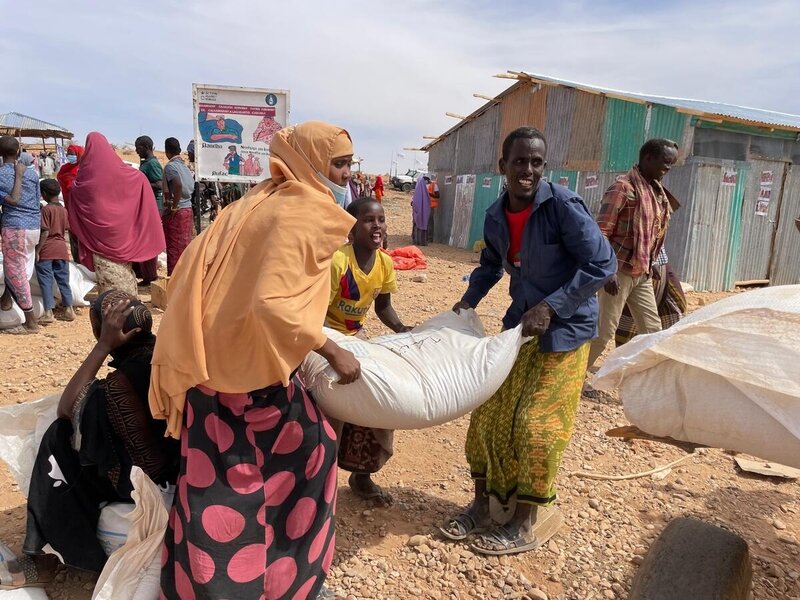By Per Olsson, Rattvisepartiet Socialisterna (our sister organisation in Sweden)
After the 2011 famine in Somalia, the world’s power elite said, “never again”, but now the disaster is happening all over again, and even more people are at risk of starvation.
Global hunger is increasing at an alarming rate due to the toxic combination of wars, global warming, capitalism and landlordism, along with the current “apocalyptic” levels of food price increases and the shock to food supply delivered by the war in Ukraine. The war is exacerbating spiraling global food and fuel prices.
But even before Russia invaded Ukraine, the world faced a food insecurity crisis and global food prices, which have been on the rise since mid-2020 are now at an all-time high.
The crisis is also getting worse due to the global rise of food protectionism.
The problem is not that there are too many people to be fed. Enough food is produced today to feed everyone on the planet. The problem is, as even the UN has to confess, “access and availability of food, which is increasingly impeded by multiple challenges including the COVID-19 pandemic, conflict, climate change, inequality, rising prices and international tensions. People around the world are suffering the domino effects of challenges that know no borders”.
What stands in the way of feeding the hungry and achieving the necessary global redistribution is the capitalist mode of production — based on the private ownership and control of the means of production, resources, wealth, distribution and the barrier represented by the nation-state. This is particularly the case now, when capitalism has become more and more parasitic and could be termed “disaster capitalism”.
“Conditions now are much worse than during the Arab Spring in 2011 and 2007–2008 food price crisis, when 48 countries were rocked by political unrest, riots and protests,” warned the World Food Programme, WFP, Executive Director David Beasley recently.
East Africa
East Africa is a part of the world that is hardest hit, where the hunger crisis is extremely acute. The number of children facing severe acute malnutrition in Ethiopia, Kenya and Somalia has increased by more than 15% in the space of five months. “An estimated 386,000 children in Somalia are now in desperate need of treatment for life-threatening severe acute malnutrition — now exceeding the 340,000 children who required treatment at the time of the 2011 famine.” An explosion of child deaths is imminent in the Horn of Africa, warned UNICEF at the beginning of this week (7 June).
“One person is likely dying of hunger every 48 seconds in drought-ravaged Ethiopia, Kenya and Somalia. The number of people experiencing extreme hunger in the three countries has more than doubled since last year — from over 10 million to more than 23 million today. This is against a backdrop of crippling debt that more than tripled in under a decade — from $20.7 billion in 2012 to $65.3 billion by 2020 — sucking these countries’ resources from public services and social protection”, according to a new report by Oxfam and Save the Children: “ Dangerous Delay: The Cost of Inaction”, published 18 May 2022)
East Africa has been hit by the worst and longest drought in 40 years, after a fourth consecutive below‑average rainfall season. The last seasonal rain, in March-May this year, was minimal. “The 2022 March-May rainy season appears likely to be the driest on record, devastating livelihoods and driving sharp increases in food, water, and nutrition insecurity. An estimated 3.6 million livestock have died in Kenya (1.5 million) and Ethiopia (2.1 million). In the worst-affected areas of Somalia, it is estimated that 1-out-of-3 livestock have perished since mid-2021. And there is a big risk that even the coming rain season in October-December will fail”. (World Meteorological Organization, WMO, 31 May).
After the 2011 famine in Somalia, the world’s power elite said, “never again”, but now the disaster is happening again, and even more people are threatened by starvation.
$4.4 billion worth of aid and assistance would be needed to sustain 30 million people in Ethiopia, Kenya and Somalia, according to Oxfam and Save the Children report. That sum is equivalent to half a percentage point of annual US military spending, or only half of what oil giant Shell paid its shareholders in dividends (in the form of buybacks schemes) in the first six months of the year.
Capitalists stand In the way Of action
Capitalism and government policies prevent the resources that exist from being distributed to those in need. The UN Children’s Fund, UNICEF, has just received a fifth of the money it says it needs to feed the starving and provide clean water.
Governments in richer countries cut aid or use it as a means of “conditional humanitarianism” for their own purposes and interests. Aid funds are raided in order to finance an increase in military expenditure. The German government has decided to boost military spending at the expense of aid, while all governments in Scandinavia have used aid funds to finance alleged costs for Ukrainian refugees — this in turn makes the Swedish government the biggest recipient of its own development aid.
In the UK, despite the acute crisis, “figures published in the Foreign, Commonwealth and Development Office (FCDO) annual report last year revealed direct UK aid and planned aid to Ethiopia fell from £241m in 2020/21 to £108m in 2021/22, a cut of 55%; aid to Kenya fell from £67m to £41m, a cut of 39%; and aid to Somalia fell from £121m to £71m, a cut of 41%”. (The Guardian 22 May)
Climate crisis
Governments in the richer capitalist countries have made several promises of tackling climate and pledges to “help” poor countries adapt to climate changes, but never delivered. This just adds insult to injury as the world will face around 560 disasters every year by 2030, compared to 350–500 disasters every year over the last 20 years, because of climate change and the impasse of capitalism.
“The economic cost of extreme weather events in 2021 alone was estimated to be $329 billion globally, the third highest year on record. This is nearly double the total aid given by rich nations to the developing world that year.” (Oxfam 7 June)
The need for immediate aid and assistance is urgent, but solving the crisis requires fighting for revolutionary change — for climate justice, global redistribution and a democratic, socialist world.
Like in 2011, the warning bells that East Africa is heading for another famine have long been ringing loud and clear. Already in mid-2020, there were warnings of drought in East Africa, and the long-term forecasts made at the time pointed to a steadily worsening drought due to reduced rainfall. The pandemic came to further deepen the crisis that was developing.
” East Africa highlights the profound inequality of the climate crisis. It is one of the regions least responsible for the climate crisis — collectively emitting less than 0.05% of global CO2 — yet over the past decade it has been repeatedly struck by climate-related shocks. It is increasingly apparent that such shocks also act as a threat multiplier, spurring conflict and fragility. By 2030, more than 100 million people in low — and middle-income countries may be pushed below the poverty line by increasingly frequent extreme events and the climate crisis. The climate crisis will both exacerbate existing conflict and reduce people’s capacity to cope with its effects. Increased exposure to shocks also widens inequalities within communities, suppresses economic growth, and compromises the impact of long-term poverty reduction efforts. While the level of needs in 2022 are staggering, the latest UNDRR (United Nations Office for Disaster Risk) analysis indicates that far worse is yet to come ‘’ writes the report “Dangerous Delay2: The Cost of Inaction”.
While East Africa has been hit by extreme droughts due to global warming, four horrific tropical storms swept across Madagascar in as many weeks earlier this year and South Africa was hit by floods. Across Africa, food insecurity is on the rise. West Africa is hit by its worst food crisis in a decade, with 27 million people going hungry. This number set to rise to 38 million this June — a new historic record and already an increase of 25% over the last year
If current dangerous trends continue, another 100 million people will have been pushed into extreme poverty by 2030 as a result of extreme weather and climate-related disasters.
War in Ukraine means famine in Africa. Almost all the wheat and sunflower oil imported by East Africa has come from Ukraine or Russia. The war has caused the prices of these products to skyrocket. The price of wheat has risen by 20% and in Ethiopia the price of sunflower oil has risen by 215%. Somalia alone used to import 92% of its wheat from Russia and Ukraine — but supply lines are now blocked.
Sudan and Somalia — Crisis and legacy of imperialism
In Sudan, the war in Ukraine, together with poor harvests, military rule and recurrent armed conflicts, risks doubling the number of hungry people. Sudan imports more than half its wheat from Ukraine and Russia, and the price of a tonne of wheat, which accounts for a fifth of total calorie intake, is now 180% higher than a year ago. Meanwhile, high fuel prices are hitting bakeries.
Despite the crisis, it is not food, clean water and medicines that the Biden administration has decided to send to Somalia, but US troops, 500 soldiers.
US military operations in Somalia, which began back in the 1990s and were supposed to be a humanitarian effort against hunger, ended in disastrous street battles in Somalia’s capital Mogadishu in October 1993 that killed hundreds of Somalis, including civilians. 19 US soldiers were killed and 73 injured and two Black Hawk helicopters were shot down. The battle that waged through Mogadishu lasted two days and became a defining moment for US imperialism, giving rise to the “Somalia Syndrome” of not crossing “the Mogadishu line” and risking losing more prestige and the life of US soldiers.
The US and UN military intervention in Somalia has been a failure and has not stopped Islamist al-Shabab from continuing to terrorise the population.
“The US has been trying to fight al-Shabab with military force for 15 years, and it hasn’t worked — it may even have prolonged the conflict” (Sarah Harrison of the International Crisis Group to the New York Times on 16 May).
More recently, al-Shahab appears to have succeeded in subduing new areas of land in Somalia, which is at risk of becoming a new Afghanistan, where food security levels have plunged at a terrible rate, leaving half the population facing acute hunger.
As always, the African masses are paying the heaviest price for the crises and wars of global imperialism. Only a united struggle of workers and the poor against the policy divide and rule policies by imperialism and domestic capitalism for an international socialist transformation of the continent can chart a path away from the oppression, looting and disasters that make life a nightmare without end on the African continent.












